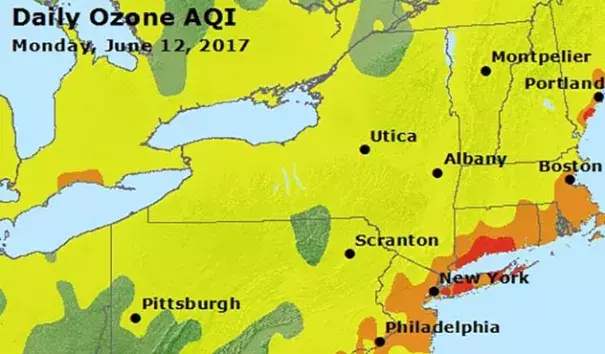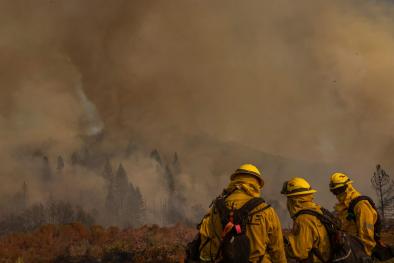Record Heat Brings First Serious Air Pollution Episode of 2017 to Northeast, Midwest

The first major heat wave of the summer for the Midwest and Northeast U.S. set numerous daily record highs on Monday, and also brought the worst ozone air pollution of the year to much of the region. Ground level ozone, which is created from chemical reactions between volatile organic carbon (VOC) compounds and nitrogen oxides, is created more readily at warmer temperatures. Monday’s record heat helped these chemical reactions occur faster, resulting in ozone pollution that topped out in the “Unhealthy” range along the coasts of Connecticut, New York and Maine.
...
Death certificates never list air pollution as the cause of death. Nevertheless, air pollution is a huge and silent killer: between 91,000 and 100,000 air pollution deaths per year occur in the U.S., according to separate studies done in 2016 by the World Bank and the Health Effects Institute (a U.S. non-profit corporation funded by the EPA and the auto industry). Air pollution deaths are calculated using epidemiological studies, which correlate death rates with air pollution levels. Air pollution has been proven to increase the incidence of death due to stroke, heart attack and lung disease. Since these causes of death are also due to other factors—such as lifestyle and family history—we typically refer to air pollution deaths as premature deaths. A premature air pollution-related death typically occurs about twelve years earlier than it otherwise might have, according to Caiazzo et al., 2013.
Approximately 12,000 of these premature U.S. air pollution deaths each year are from high ozone. Since this week’s high ozone levels are affecting a very large population of tens of millions of people, I expect that the death toll from ozone air pollution this week will be several hundred people. Tuesday, June 13 is going to be another day with poor air quality in the Northeast and Midwest United States, and air pollution action days have been declared for Chicago, Philadelphia, and New York City, as well as parts of New Jersey, Rhode Island, and Massachusetts.
Record highs for Monday, June 12, 2017
- Atlantic City, New Jersey, 94°
- Allentown, Pennsylvania, 92° (tied)
- Harrisburg, Pennsylvania, 92° (tied)
- Lansing, Michigan, 95° (tied)
- Worcester, Massachusetts, 90° (tied)
- Providence, Rhode Island, 95°
- New York City, 93° (tied)
- Newark, New Jersey, 97°
- Cleveland, Ohio, 93°, (tied)
- Albany, New York, 95°
- Washington D.C., 95° (tied)
- Bridgeport, Connecticut, 93°
Related Content



